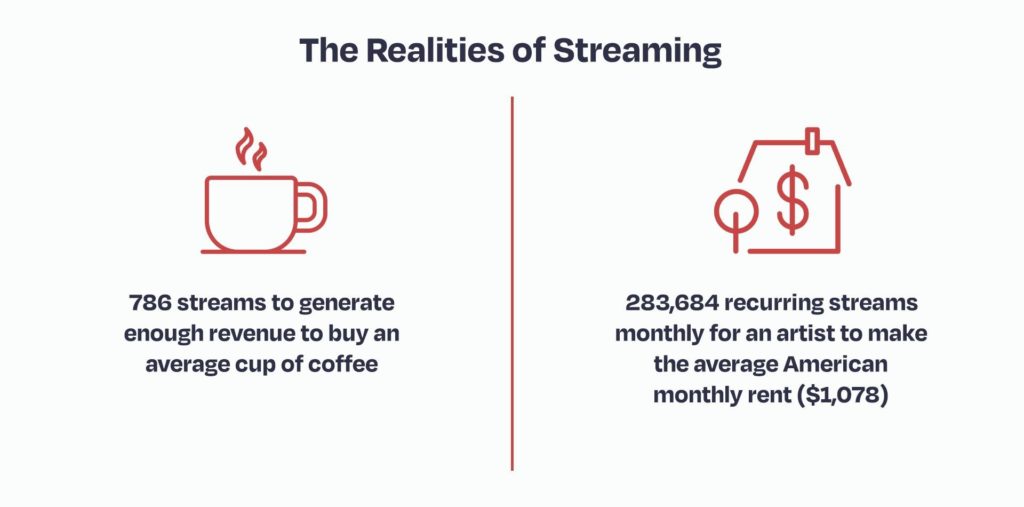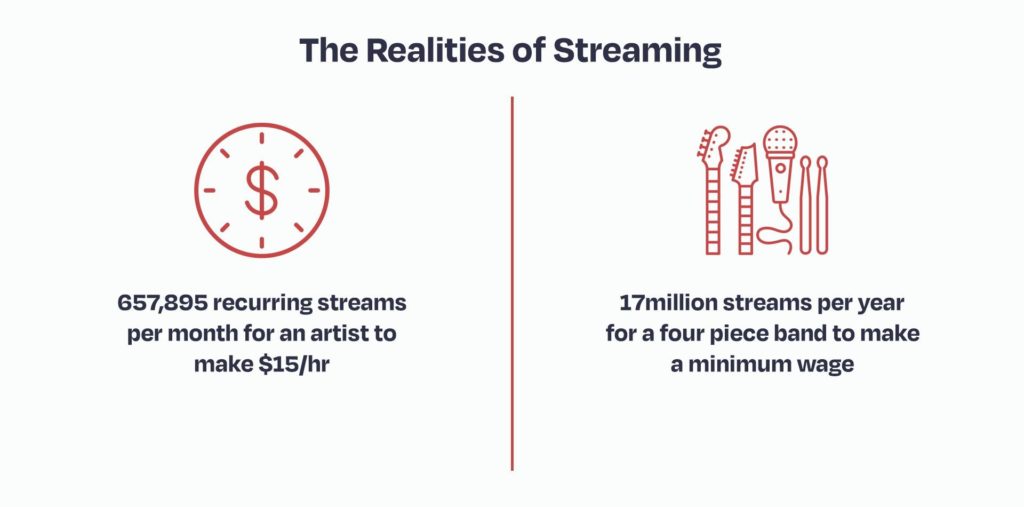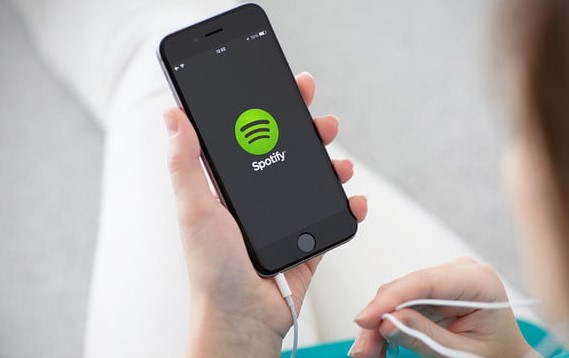Tom Greenwood (Leyton and Wanstead CLP), a band member and respected session musician, asks “Who’s makes all the money from music streaming?”
The music streaming industry is booming but the people who make the music aren’t seeing any of it. In 2012, the official charts recognized the first number one from streaming. Since then, streaming has gone on to be the main way that music is consumed. When the Coronavirus pandemic hit, musicians found themselves having to rely on their streaming revenue and merchandise sales alone. The numbers for streaming have doubled over the last year, with Spotify announcing that they are now worth over $60bn, while three major labels are making a profit of $19bn a day!
Traditional record deal
To understand just how bad things have got for musicians, we have to go back and take a look at what a traditional record deal would have entailed. Recording contracts have never been good for artists and only the biggest acts could ever hope to negotiate something better. It used to be that a record company would pay the artist an advance for them to make an album, much like an author of a book. This advance would cover the artists wage for 2-3 years; recording costs for the album; promotional costs for hiring PR companies and radio pluggers; touring costs to promote the album; and the fees to lawyers.
After all that was accounted for, the artist’s manager would then take a 20% cut of all of the money going towards the bands living costs. In return, the record company would own the artists’ original recordings of the songs for the album, the ‘masters’, for 50 years.
Why artists put up with it?
With a major record label, an artist can expect to see 13-18% of the royalties, with the rest being retained by the label in return for their payment of advances. With indie labels, it used to go as high as 50% but with the understanding that the advance would be worth less. A good example of an artist who made a lot of money but only saw a bit of it was Mick Hucknall of Simply Red . It’s reported he made almost £200m for Warner Chappell and saw just (!) £20m of it. Perhaps that’s why artists have put up for years with the music industry being so terrible. As long as there’s lots of money to be made, who really cares?

During the 90s, the CEOs of all the major recording companies were warned by Silicon Valley types that if they didn’t act quickly in setting up an alternative to CD sales then music would soon be available for free because internet-sharing speeds would be so fast that downloading a song would happen in nanoseconds. If the music industry didn’t come up with its own solution, then soon the whole industry would be under threat from illegal downloading sites. The problem was that this would mean taking preventative action which would result in some short-term loss of profits.
Industry freaked out
Much like the pleas of scientists about the climate crisis today, these warnings fell on deaf ears. In the late 90s and early 2000s, crude downloading apps like Napster and Limewire started making their way onto every desktop computer in the world. The industry completely freaked out, with constant calls on governments to do something.
The US government responded by threatening to jail anyone who illegally downloaded a song, equating it to being just as bad as stealing from a shop – but it was already too late. For every illegal downloading app that they shut down, another one was created. The internet was moving at a faster pace than anyone could keep up with and the inaction of the music industry let it all happen. Between 1999 and 2008 the music industry lost over £5bn in physical sales and it seemed like nobody had the answer to how to solve it.
To counter the loss of profits, record deals became a lot worse. In 2002, the world’s first ‘360 record deal’ was announced. This was the music industry’s way of keeping profits alive. Rather than the artist handing over just the master recordings of their songs, they also handed over a certain percentage of their publishing and a split on all of their ticket sales. For this exchange, they received a smaller advance, which would only keep them afloat for a year, and half the amount in recording budgets. Within years, some of the world’s most famous recording studios had to close. To summarise the situation, the artist was giving away a higher percentage of all of their profit streams for less money over less time!
Verge of collapse
By 2009 it seemed like the recording industry was on the verge of collapse; 95% of all music downloaded was done so illegally. The record companies were desperate and found themselves finally ready to listen to the advice given to them back in the 90s. Spotify was just one of many streaming sites into which the industry poured money, in the hope that it would turn its fortunes around. In March 2009, Spotify launched as a music-only streaming service.
Spotify works on a ‘freemium and subscription’ model. The consumer can either listen to an advert every couple of songs or pay a monthly subscription of £9.99. The profits of these ads or subscriptions are then shared out amongst Spotify, its shareholders, the record labels, and then, finally, the artists. But not everyone is seeing their fair share.
Currently, Spotify pays artists using a ‘pro-rata’ model, in which all revenue is pooled, then distributed to artists according to a complex scheme. The pro-rata model means that as artists on the top of the pyramid accumulate a greater percentage of streams, all other artists receive increasingly tiny payments. Put simply, if someone was to stream my band’s latest song on Spotify, Coldplay would see more money from it than I would!

One of Spotify’s core goals is to give “a million creative artists the opportunity to live off their art.” Yet, in order to generate a single dollar on the platform, a song needs to be streamed 263 times. To put that in perspective, it would take 786 streams to generate enough revenue to buy an average cup of coffee. To pay the median American monthly rent ($1,078), an artist needs to generate 283,684 recurring streams monthly. And to earn $15/hr, each month working full time, it would take 657,895 streams per band member. For a four-piece band to make a minimum wage each in one year, it would require them to have over 17million streams!
Cool, artist-friendly company?
Spotify spends a huge amount of money each year on PR and advertising to make them look like a young, cool, artist-friendly company but in reality, they are nothing more than the Amazon or Tesco of music, a monopoly that has swallowed all in its path, not only replacing all the bricks-and-mortar record stores, but also the radio stations, the charts and the music channels on TV.
It used to be that when releasing a song, the record company would employ a radio plugger to take the song around all the radio stations relevant to the artists’ music to get them on their “playlist”. Now, they have to convince Spotify to put them on the playlists that it prioritises and promotes. These playlists are the most influential in the world; if an artist is placed at the top of the Friday new-music list one week, then it’s guaranteed to be in the charts the next.
How Spotify decides who goes on what playlist is shrouded in complete secrecy. Moreover, they encourage a ‘pay for play’ system where the record companies can pay a sum of cash to Spotify in exchange for putting their artist on one of the most popular playlists. It really is no different than some guy handing an envelope under the table stuffed full of £20 notes!
Profiteering
In order to increase its own power and profits, Spotify have even tried to clamp down on artists or bands pitching to other users to be put on playlists that they have set up. Let’s just call this what it is – rampant, capitalist profiteering hiding behind the image of a respectable music-loving, digital company.
Up until 2020, the fightback against Spotify was limited to either a few principled artists at the top of the chain or a few really small acts who never got a look-in any way. Everyone else has been frightened into silence, realizing that if you come out publicly against them, then you may as well kiss goodbye to a career in music. Better to just accept what you’re given and try to make as much money from touring as you can. But once the pandemic hit, this finally started to change.

In the UK the Musicians Union (MU) has started a ‘Fix The Streaming’ campaign which calls for Spotify to adopt a ‘user-centric’ model, meaning that whatever artist the user listens to will receive the money, unlike the current pyramid scheme. While it is certainly a promising start, the demands could go a lot further. A user centric model would go some way to making more money for artists but it won’t solve the fundamental problem, which is that record companies, that have never invested in you as an artist, are seeing more money from your stream than you are.
Take some inspiration
The MU in Britain could take some inspiration from the demands made by the ‘Union of Musicians and Allied Workers’ (UMAW), a new smaller union for musicians formed in the US. The UMAW is calling for a ‘user-centric’ model of a penny per stream; but also, for transparency of all closed contracts, including those relating to playlists; and credit for labour involved in the making of the recordings. Spotify says their penny per stream demand is unstainable. The UMAW answer to this is ‘If Spotify’s model can’t pay artists fairly, it shouldn’t exist.’
Clearly, Spotify isn’t working for musicians, but its existence does prove that there can be a managed, centralized system where everyone can share in all the music created. A nationalised Spotify is possible, democratically controlled by musicians, other music professionals and representatives from wider society, and with full transparency about its practices. But it will take a fight!
It’s not just the musicians that are missing out on payment but it’s society that’s missing out on art. Imagine what could be created if artists weren’t chained to the profit motive; if they knew that they were free to create and experiment without it having a negative impact on their livelihood.
How many potential artists are out there that don’t have access to recording facilities or have simply given up because they need to make a living. Or as Trotsky once put it ‘How many Aristotles are herding swine, and how many swineherds are sitting on thrones?’.



